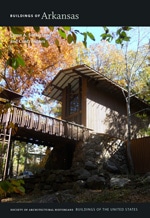Rivaled in monumentality only by the nearby courthouse, the First Methodist Church forcefully marks the beginning of downtown. Sited close to the sidewalk, its long rectangular massing stretches half a block along 4th Street, and the red brick Tudor Revival design features a dramatic three-story projecting central entrance that indicates the division of the sanctuary from the educational wing. The entrance is surmounted by a jerkinhead gable and flanked by massive octagonal brick piers with conical spires that convey the appearance of a medieval gateway as much as an embellishment to a door. The Tudor Revival air was diluted somewhat by the replacement of the transomed windows in the educational wing and in the sanctuary and the insertion of stained glass windows in the arched spaces formerly filled with clear multipaned fenestration capped with tracery. The sanctuary interior was entirely remodeled in the 1960s. After a fire in 1922 destroyed the previous church, the building committee wisely engaged Columbia University–trained Almand, who, as a devout Methodist, produced forty-one designs for congregations of that denomination in Arkansas.
You are here
First United Methodist Church
If SAH Archipedia has been useful to you, please consider supporting it.
SAH Archipedia tells the story of the United States through its buildings, landscapes, and cities. This freely available resource empowers the public with authoritative knowledge that deepens their understanding and appreciation of the built environment. But the Society of Architectural Historians, which created SAH Archipedia with University of Virginia Press, needs your support to maintain the high-caliber research, writing, photography, cartography, editing, design, and programming that make SAH Archipedia a trusted online resource available to all who value the history of place, heritage tourism, and learning.






